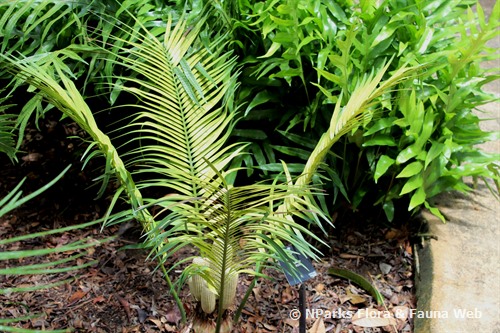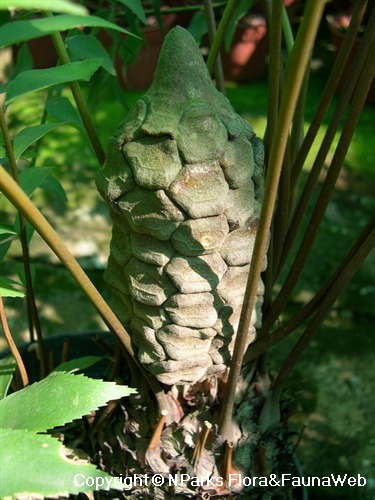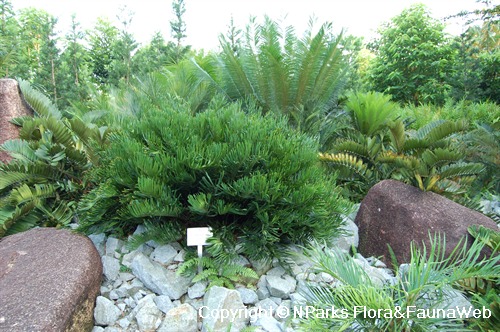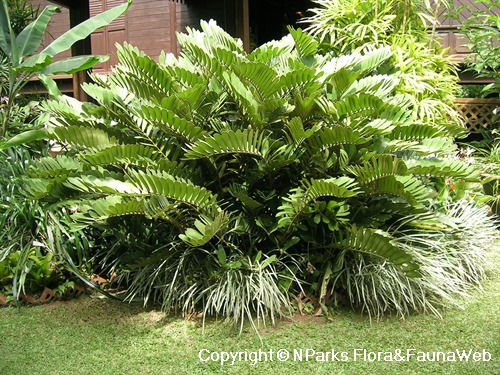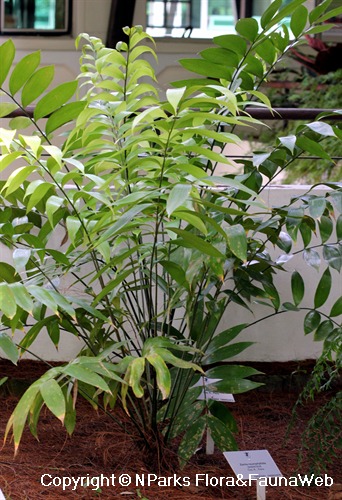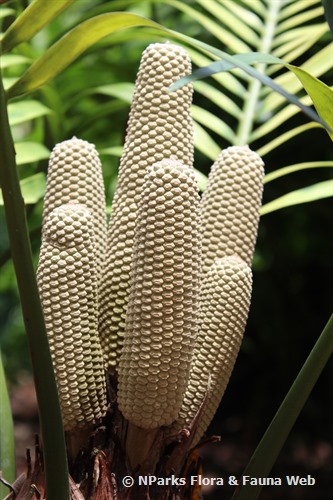
Name
Classifications and Characteristics
| Plant Division | Gymnosperms (Non-Flowering Seed Plants) |
|---|---|
| Plant Growth Form | Cycad |
| Lifespan (in Singapore) | Perennial |
| Mode of Nutrition | Autotrophic |
Biogeography
| Native Distribution | Veracruz |
|---|---|
| Native Habitat | Terrestrial |
Description and Ethnobotany
| Growth Form | It is a small cycad with underground or above-ground trunk, up to 30 cm tall and often unbranched. |
|---|---|
| Foliage | Each crown has 10 – 25 mature leaves which are erect and arching, borne on 10 – 25 cm petiole. Petiole is smooth with a swollen and hairy base. Each leaf has about 50 – 65 linear-lanceolate leaflets (20 – 30 cm long and 0.9 – 1.5 cm wide). Cataphylls are present at the tip of the trunk, triangle shaped ( 4 – 6 cm long) and resembles scale leaves. The cataphylls act as a protection against damages from fire and herbivory. |
| Reproductive Parts - non-flowering plant | Male cone is cylindrical to ovoid-cylindrical (9 – 19 cm long and 2.5 – 3 cm wide), light brown to blackish and occurs in cluster of 1 – 6. Female cone is barrel-shaped (13 – 20 cm long and 8.5 – 10 cm wide), brown to blackish and occurs in cluster of 1 – 3. Seed oval-shaped (1.5 – 2.2 cm long and 1 – 1.5 wide) with red to brown seed coat. |
| Habitat | It is found growing near cliffs in deciduous forest, up to 300 m altitude. |
| Cultivation | Seed formation and seedling recruitment are observed to be poor in the wild, suggesting that its natural pollinator may have become extinct. |
| Etymology | Zamia, greek for azaniae, which means ‘pine-cone-like’, referring to the reproductive structures. Specific epithet inermis, in latin, means unarmed or lacking spines or pricks. |
Landscaping Features
| Desirable Plant Features | Ornamental Form |
|---|---|
| Landscape Uses | Parks & Gardens |
Plant Care and Propagation
| Light Preference | Full Sun |
|---|---|
| Water Preference | Little Water |
| Plant Growth Rate | Slow |
| Rootzone Tolerance | Well-Drained Soils |
| Propagation Method | Seed |
Foliar
| Foliage Retention | Evergreen |
|---|---|
| Mature Foliage Colour(s) | Green |
References
| References | Jones, D.L. 2002. Cycads of the World. Ancient Plants in Today's Landscape. 2nd Edition. United States of America: Smithsonian Institution Press. 456 |
|---|
Image Repository
Others
| Master ID | 32955 |
|---|---|
| Species ID | 7369 |
| Flora Disclaimer | The information in this website has been compiled from reliable sources, such as reference works on medicinal plants. It is not a substitute for medical advice or treatment and NParks does not purport to provide any medical advice. Readers should always consult his/her physician before using or consuming a plant for medicinal purposes. |

